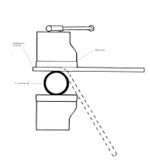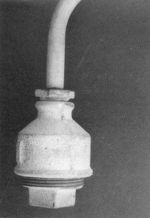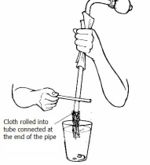How to make and use a simple retort for separating gold-mercury amalgam[edit | edit source]
Mercury is used in amalgamation to recover gold in its native or 'free' form. While mercury simplifies the process greatly, it must be remembered that it is a very dangerous substance, especially when inhaled or absorbed through the skin.
Mercury is an 'accumulative' poison, meaning that repeated exposure, even of very small amounts, can build up in the body, leading eventually to mercury poisoning.
Mercury released into the atmosphere is also dangerous because it combines easily with other substances (such as hydrocarbons) to form compounds which can easily be taken up by other organisms, such as fish and shellfish. A build-up of mercury in these organisms can make them dangerous to eat.
Signs of serious mercury poisoning include stomach pains, vomiting, headaches, shaking, collapse, diarrhoea and, occasionally, cardiac weakness. Indications of low-Ievel mercury poisoning include nervousness, depression, vague fears, sleeping difficulties, reduced vision and poor co-ordination of the limbs.

The need for a closed retort[edit | edit source]
Because of these dangers, it is very important to handle mercury extremely carefully. When working with gold amalgam, the mercury should be distilled in a closed retort. This not only ensures the health of those involved and protects the environment, but the mercury can also be recovered for future use.
Fabricating the retort[edit | edit source]

Parts required[edit | edit source]
The retort's pipe and fittings, except for the wooden stopper (2e) should be made from ordinary galvanised iron. Piping made from copper or other metals should not be used as these combine readily with mercury.
- 20-inch length of 1/4-inch-diameter galvanised iron pipe (2a), with screw thread at one end. (If 1/4-inch pipe is not available, then use 1/2-inch pipe, but note that the smaller the pipe diameter the better)
- 1/2-inch to1/4-inch galvanised iron pipe reducing bush (2b)
- 1/2-to-1 &1/2-inch galvanised iron pipe reducer (2c)
- 1 &1/2-inch galvanised iron pipe plug (2d)
- a wooden stopper to fit the 1/4-inch pipe (or 1/2-inch) discharge end (2e).
- piece of tightly woven cotton cloth, about 3 inches by 5 inches, to be rolled into tube connected at the end of the pipe to serve as final discharge outlet) . This is included to prevent possible reverse suction of water when the retort is removed from the heat while the discharge end is dipped into the water in the glass.

Preparation[edit | edit source]
- Bend the pipe 4 inches from the threaded end into a smooth curve, with an angle of about 60-70 degrees. If possible, use a pipe bending machine to have a smooth curve. Alternatively, clamp the ¼-inch diameter pipe (2a) to a larger diameter pipe (4 to 6-inch) and then manually bend it around the bigger pipe (Figure 3).
- Heat the pipe and fittings until red hot, before assembly, to burn off the zinc coating (zinc reacts with mercury).
- Allow the retort to cool, then wash it.


Assembling the retort (Figure 2)[edit | edit source]
- Connect the 1/2-inch-to-1/4-inch reducing bush to the1/4-inch diameter pipe (2b to 2a) by screwing tightly. Note: The reducing bush is not obviously required if a 1/2-inch diameter pipe is used.
- Connect the 1&1/2-inch-to-1/2-inch reducer to the ½-inch-to-1/4-inch reducing bush (2c to 2b) by screwing tightly.
- Connect the 1&1/2-inch plug to the 1&1/2-inch-to-1/2-inch reducer (2d to 2c).
- The retort is now ready for use.
Using the Retort[edit | edit source]
Purpose[edit | edit source]
The purpose of the retort is to separate the gold from the mercury components of the gold amalgam. By applying heat to the amalgam (Figure 1), the mercury is burnt off as a gas, which passes along the pipe to re-condense as a liquid. The gold remains in the distilling chamber of the retort, while the mercury is collected at the discharge end in liquid form.

Process[edit | edit source]
Wrap the amalgam into small balls with a piece of paper (the foil from a cigarette packet is ideal). This will help prevent the gold from sticking to the distilling chamber under heat. Note: Wear rubber gloves whenever you are handling mercury to avoid contact with the skin.
Place the wrapped amalgam in the plug (2d) and screw tightly.
Seal all the joints with wet clay or mud. This will prevent mercury gases escaping into the atmosphere during the heating process.
Prepare the source of heat, normally charcoal (an oxy-acetylene torch can also be used).
Secure the retort on a stand that places the distilling chamber directly over the source of heat. At the discharge end, place a glass of water, with the cloth "tube" connected at the end of the pipe submerged (Figure 1).
Use bellows to increase heat. Continue applying the bellows until the distilling chamber is red hot or bubbles stop coming out of the discharge end. This part of the process normally takes about 5 to ten minutes.
Remove source of heat and allow the retort to cool down using a wet cloth or water, but taking care to keep the "cloth tube" connected at the end of the pipe submerged in water to avoid mercury gas from escaping.
With the retort vertically with the discharge end still submerged in the water (as Figure 6), tap the pipe with a stick to dislodge any mercury still in the pipe.
Remove the retort from the water and cover the discharge end immediately with the wooden stopper.
Allow the distilling chamber to cool first before proceeding to remove the gold.
Unscrew the plug and remove the gold. Screw the plug back immediately and remember to keep the retort fitted tightly together at all times after use, as some of the mercury will remain trapped.
Transfer the recovered mercury to a proper container. To prevent evaporation of mercury while being stored, put a layer of water over the mercury.
Store the container and the retort safely, out of sunlight, away from heat and out of reach of children.
First aid treatment for mercury poisoning[edit | edit source]
- Inhalation Remove the victim to a cool, well ventilated area; lay him on his back; loosen collar and belt; speak reassuringly; if victim is coughing badly, make him inhale (breathe) through a clean cloth soaked with a little ethyl alcohol or ether.
- Swallowing Make the victim rinse his mouth with cold water; take him to a cool, well ventilated area; loosen collar and belt; give plenty of water to drink; induce vomiting; if possible, feed with milk and raw egg, raw egg alone or table oil.
- Skin contact Remove clothing on affected area, wash affected area with running water; rinse and dry carefully.
- Eye contact Wash affected eye immediately under running water with eyelids held wide apart and the victim's eyes moving in every direction; continue washing to be sure no particles of mercury remain in the eye; prevent victim from rubbing eyes.
Notes: In all cases of mercury poisoning, refer victim to a doctor after giving First Aid. Never try to make an unconscious person take a drink. Never use any oily substance or ointment without medical advice.
| Practical Action The Schumacher Centre for Technology and Development |